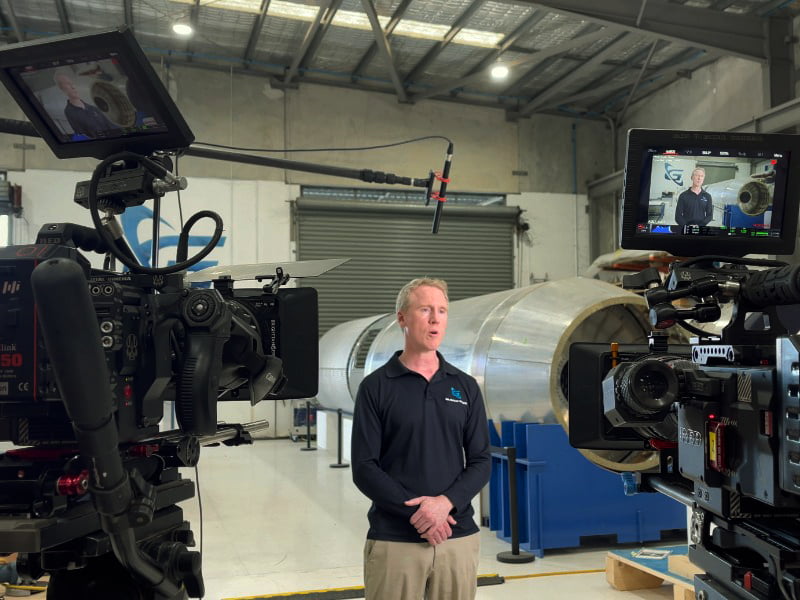Gold Coast-based rocket manufacturer Gilmour Space Technologies has revealed long term plans to put Australian astronauts into space aboard crewed flights inside ten years.
In that time, the company aims to become a transportation system of choice to and from the moon in support of international space exploration missions, in addition to delivering regular commercial payloads to orbit.
Gilmour Space chief executive officer Adam Gilmour says the company is on track in preparations to launch the first build of its Eris three-stage orbital vehicle by the end of the year, with construction work on the Abbot Point launch site in North Queensland well underway.
The Eris rocket, aside from its payload fairing and stage-separation device, is entirely designed and built in Australia, either on-site at the Gilmour facility on the Gold Coast, or through a local supply chain of 300 companies.

“We do all of the assembly here. We do the avionic systems here, all of the software, and all the rocket motors we build ourselves, and then we have used our partners to build the fuselage sections of the rocket,” Mr Gilmour said.
Speaking to InnovationAus.com as part of filming for a mini documentary on the ambitions and opportunities for building a vertically integrated space sector that includes the manufacture of satellites and other spacecraft as well as launch vehicles, Mr Gilmour and other senior Gilmour managers publicly revealed the breadth of the company’s plans for the first time.
The company, which was founded in 2015 and currently employs 140 staff, has the moon in its sights.
“In five years, we should be pushing through to 500 to 600 employees,” Mr Gilmour said. “We want to have [put] payloads into geostationary orbit. We want to have payloads around the moon.”
“If we are really good, we’ll have a payload on the moon that’s through our technology, [and] in ten years I am super confident we will. Human space flight in ten years is another of our ambitions,” he said.
The company, which currently has about 50 job openings right now, is advertising for a lead mechanical engineer for space craft as part of a first step toward building a crew capsule in anticipation of sending astronauts to space.
Gilmour Space Technologies chief of staff Nick Lindsay – a nine-year veteran of Elon Musk’s SpaceX – says the global launch market is huge and the opportunity to build a genuinely vertically integrated advanced manufacturing and launch sector for space is real.
“There are more satellites than there are available rockets to launch those satellites,” Mr Lindsay said. “And that’s for the next ten years.”
“So, there is the commercial opportunity of helping to deliver advanced technologies developed here in Australia,” he said.
“If you look at the defence, sovereign capability side of things, we are developing advanced rockets and satellites that are going to be less expensive, [and] made right here in Australia, by Australians.”
“Our goal is to be very vertically integrated … And that’s something that doesn’t really exist in Australian manufacturing right now, and definitely doesn’t exist in aerospace manufacturing,” Mr Lindsay said.
While Gilmour Space is managing expectations for its first Eris launch – historically no rocket company has succeeded in reaching orbit on its first attempt – the company expects that in five years the pace of launches will accelerate quickly to one launch every month or two.
The company has near term plans to move from its Block 1 Eris launch vehicle to its Block 2 Eris version, delivering a seven-fold increase in performance.
“Fast forward ten years and we have really lofty ambitions. We want to be the transportation system to and from the moon as mankind explores further and further into our solar system,” Mr Lindsay said.
“I hope [in that timeframe] that we are supporting SpaceX’s mission to take mankind to Mars. We will be developing larger and more capable and more complex space craft and satellites,” he said.
“I also think we will be moving toward crewed missions, developing a space craft – a crew capsule – to carry Australian astronauts into orbit.”
For Adam Gilmour, building a complex orbital vehicle system in Australia as the prime contractor leading a group of Australian suppliers is a powerful demonstration of advanced manufacturing capability.
That is a large part of Gilmour’s ambition. A successful launch will come, but managing public expectations is important.
“If you look historically at rocket companies around the world that have attempted to launch their first rocket, no-one has succeeded on the first attempt,” Mr Gilmour said. “So, history tells us we should manage our expectations.”
And if you look at those first attempts, there are some that never leave the pad, and others that just don’t make it all the way. So, what does success look like?
“For me, I would love to see at least the first stage finish its burn, separate into the second stage – and then the second stage ignition – and moving toward space,” Mr Gilmour said.
“If that happens, then 60 per cent to 70 per cent of all the systems on the rocket will have been flight tested,” he said.
“That gives us a lot of power to analyse the systems for our second launch attempt and to make that a success.”
InnovationAus.com will show its mini-doco on Gilmour Space Technologies at The Innovation Papers policy forum in Canberra in August.
Do you know more? Contact James Riley via Email.

